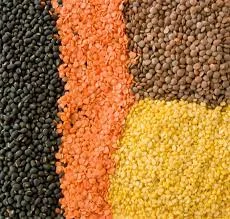
Why Lentil Production in News?
- According to the Ministry of Consumer Affairs, increased acreage will cause India to overtake other countries as the world’s leading Lentil Production in the 2023–24 crop year. On larger acreage, the nation’s lentil production is predicted to reach an all-time high of 1.6 million tones in the 2023–24 rabi season. Based on official data, the nation produced 1.56 million tones of lentils during the 2022–2023 crop year.
What are Lentils?
- About:
- A bushy annual herbaceous plant belonging to the legume family is the lentil.
- These are edible legumes distinguished by their flat, disc-shaped, lens-shaped seeds.
- Usually small in stature, lentil plants produce blooms that pollinate themselves.
- Excellent providers of energy, carbs, protein, fat, fiber, iron, zinc, phosphorus, carotene, vitamins, and antioxidants are lentil grains.
- Climate:
- Rainfed agriculture is the main method used to cultivate lentils.
- When it is growing vegetative, it needs cold temperatures, and when it reaches maturity, it needs warm temperatures.
- Rabi season is when lentils are grown.
- Soil Types:
- Deep sandy loam soils with moderate fertility are ideal for lentil growth, while they can be grown in a variety of soil types, including sand and clay loam.
- The ideal pH for soil would be about 7.
- Flooding and soggy weather are intolerable to lentils.
- Growing Regions for Lentils:
- Bihar, West Bengal, Uttar Pradesh, Madhya Pradesh, Chhattisgarh, and Jharkhand are the states where lentils are primarily grown.
- Considered a lentil bowl, the Bundelkhand region of Uttar Pradesh and Madhya Pradesh provides around 25% of the nation’s lentil crop.
- The Food and Agriculture Organization (FAO) reports that Canada, India, Australia, Turkey, and Russia were the leading lentil producers worldwide in 2022.
- India, the world’s second-largest producer of lentils, has up until now relied on imports to cover its domestic needs, primarily from Turkey, Australia, Canada, and Russia.
What is the status of Pulse Production in India?
- India holds the world’s top position in terms of importing (14%), utilizing (27% of global consumption), and producing (25% of global output) pulses.
- Pulses cover approximately 20% of the land allocated to grains and contribute between 7% and 10% to the nation’s overall grain production.
- Gram constitutes the most commonly produced pulse, accounting for around 40% of the total production, followed by Tur/Arhar (15–20%), Urad/Black Matpe, and Moong (8–10%).
- While pulses are cultivated in both Rabi and Kharif seasons, Rabi pulses contribute over 60% to the total production.
- The top five states for pulse production are Karnataka, Madhya Pradesh, Maharashtra, Rajasthan, and Uttar Pradesh.
What are the government initiatives aimed at boosting pulses production in India?
- Policy Support:
- The government provides policy support by ensuring reasonable prices to farmers through the procurement of pulses via Minimum Support Prices (MSP).This is facilitated through entities like the National Agricultural Cooperative Marketing Federation of India (NAFED) and, more recently, the Small Farmers Agri Consortium (SFAC).
- National Food Security Mission (NFSM)-Pulses:
- The National Food Security Mission specifically targets pulses production to enhance food security in the country.
- It provides financial and technical support to farmers to increase pulses production through various interventions.
- ICAR’s Role in Research and Variety Development:
- The Indian Council of Agricultural Research (ICAR) plays a crucial role in conducting research and developing improved varieties of pulses.
- These efforts aim to enhance yields, resistance to pests and diseases, and overall productivity of pulses crops.
- Pradhan Mantri Annadata Aay SanraksHan Abhiyan (PM-AASHA) Scheme:
- This scheme, launched by the government, focuses on ensuring remunerative prices to farmers for their produce.
- It includes various components such as Price Support Scheme (PSS), Price Deficiency Payment Scheme (PDPS), and Pilot of Private Procurement & Stockist Scheme (PPPS) to support farmers in selling their pulses at profitable rates.
People also Ask
Q1: What are the most popular lentils in India?Ans: The most commonly eaten dal in India is “Masoor dal,” also known as red lentil. Masoor dal is widely consumed across various regions of India and is a popular staple in Indian households. Masoor dal has a pleasant earthy flavor and cooks relatively quickly compared to other dals. Q2: What specific government initiatives are in place to enhance lentil production within India’s agricultural sector?Ans: The government has implemented various initiatives to enhance lentil production in India’s agricultural sector. These include policies such as providing Minimum Support Prices (MSP) for lentils, promoting lentil cultivation under the National Food Security Mission (NFSM), conducting research and development activities through organizations like the Indian Council of Agricultural Research (ICAR), and implementing schemes like the Pradhan Mantri Annadata Aay SanraksHan Abhiyan (PM-AASHA) Scheme to ensure remunerative prices for lentil farmers.
Thanks for sharing. I read many of your blog posts, cool, your blog is very good.
I don’t think the title of your article matches the content lol. Just kidding, mainly because I had some doubts after reading the article.
I don’t think the title of your article matches the content lol. Just kidding, mainly because I had some doubts after reading the article. https://www.binance.com/en-ZA/register?ref=JHQQKNKN
Your point of view caught my eye and was very interesting. Thanks. I have a question for you.
Your point of view caught my eye and was very interesting. Thanks. I have a question for you.
Your article helped me a lot, is there any more related content? Thanks!